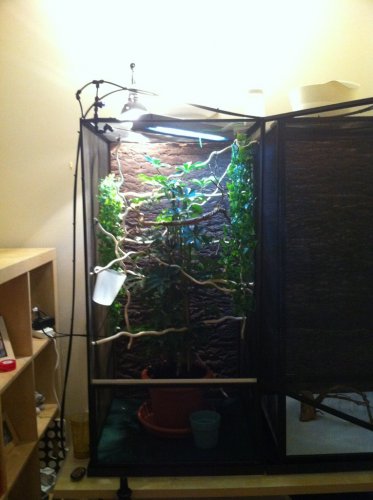Chameleon Company
Avid Member
Penelope,
Another poster beat me to it, but if coccidia were diagnosed, panacur is not the remedy. Besides the drug mentioned, we also use Albon. As we import on occasion, there are times when it is useful. Coccidia are nto so much an issue with a freshly wild-caught animal. Its the caging conditions it passes through after capture and during holding and export where it becomes more contaminated.
As for contaminated crickets, unfortunately most cricket suppliers, and especially resellers, such as pet stores, do not maintain their crickets properly so as to be instant chameleon food. The simple truth is that they do not have to, as the crickets can survive and thrive with dirty water. So they will not change-out water sources every other day, but rather maybe once a week or beyond. Only when the stink gets too bad. However, you can usually refresh purchased crickets by putting them on clean water and food for 48 hours.
We raise our own crickets here. Have for 12 years. We learned early-on about crickets and water contamination. We change our cricket waterers every two days. Its a pain in the butt, but not doing it is a catastrophe.
Some folks rely on such as plastic waterfalls, or other contraptions, to make their cage "prettier", perhaps enhance humidity, etc. All of that creates areas that are always wet, and thus quickly contaminated, and then with a little warmth and time, become sources of septic stew for loose bugs to access. Its common bacteria for the most part, but its the overwhelming volume released into the chameleon's mouth that is the dirty deed. Mucous build-up is the early warning.
I will PM you some Vitamin A info, explaining symptoms and treatment. I do not think that was your problem here, but cannot rule it out. Given time, the coccidia is certainly a game-stopper though. If there are then other issues, such as temps or nutrition, the coccidia overwhelms that much more quickly.
The learning curve has its pains ....
Another poster beat me to it, but if coccidia were diagnosed, panacur is not the remedy. Besides the drug mentioned, we also use Albon. As we import on occasion, there are times when it is useful. Coccidia are nto so much an issue with a freshly wild-caught animal. Its the caging conditions it passes through after capture and during holding and export where it becomes more contaminated.
As for contaminated crickets, unfortunately most cricket suppliers, and especially resellers, such as pet stores, do not maintain their crickets properly so as to be instant chameleon food. The simple truth is that they do not have to, as the crickets can survive and thrive with dirty water. So they will not change-out water sources every other day, but rather maybe once a week or beyond. Only when the stink gets too bad. However, you can usually refresh purchased crickets by putting them on clean water and food for 48 hours.
We raise our own crickets here. Have for 12 years. We learned early-on about crickets and water contamination. We change our cricket waterers every two days. Its a pain in the butt, but not doing it is a catastrophe.
Some folks rely on such as plastic waterfalls, or other contraptions, to make their cage "prettier", perhaps enhance humidity, etc. All of that creates areas that are always wet, and thus quickly contaminated, and then with a little warmth and time, become sources of septic stew for loose bugs to access. Its common bacteria for the most part, but its the overwhelming volume released into the chameleon's mouth that is the dirty deed. Mucous build-up is the early warning.
I will PM you some Vitamin A info, explaining symptoms and treatment. I do not think that was your problem here, but cannot rule it out. Given time, the coccidia is certainly a game-stopper though. If there are then other issues, such as temps or nutrition, the coccidia overwhelms that much more quickly.
The learning curve has its pains ....
Last edited:

